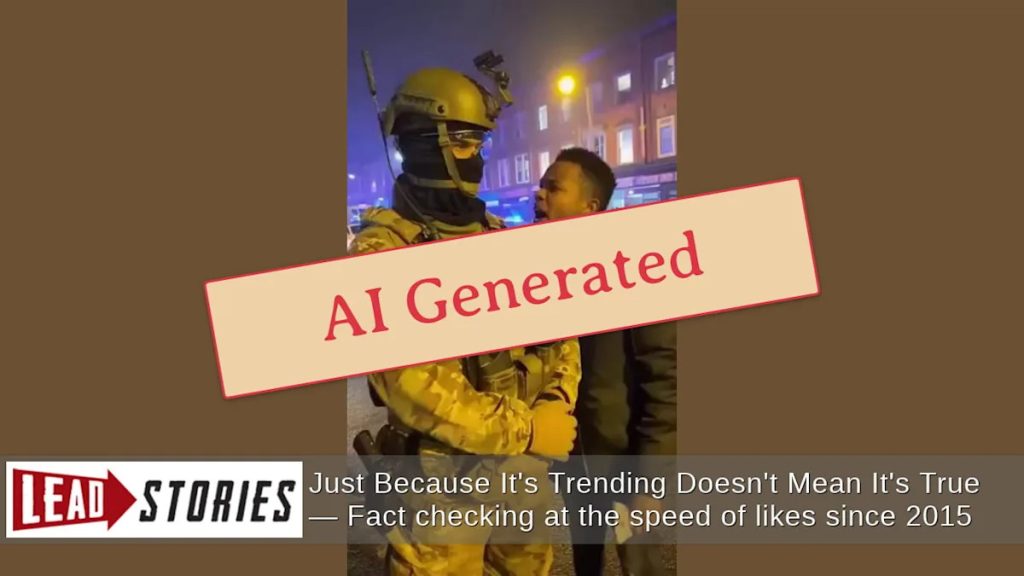Listen to the article
AI-Generated Video Falsely Shows Police Officer Pepper-Spraying Protester
A deceptive video circulating on social media allegedly showing a riot police officer pepper-spraying a protester has been confirmed as artificially generated content. The footage, which has garnered significant attention online, contains tell-tale signs of AI manipulation that expose its fraudulent nature.
The video began circulating widely after being shared on X (formerly Twitter) by user @RyanAFournier on November 6, 2025, with the caption “This is something I can watch all day… 🤣🤣🤣.” Prior to this, the content had already been spreading on other platforms, including TikTok, where it appeared as early as October 27 without any disclaimers identifying it as synthetic media.
Digital forensics experts quickly identified a critical flaw in the video’s authenticity. Close examination reveals that during the confrontation, the officer’s pepper spray canister visibly falls to the ground, yet the spray continues to stream from the officer’s empty hand – a physical impossibility that clearly demonstrates the video’s artificial origin.
This incident highlights the growing challenge of identifying and combating AI-generated misinformation. As artificial intelligence tools become more sophisticated and accessible, the potential for creating convincing but entirely fabricated content increases. Such videos can be particularly problematic in contexts involving law enforcement, protests, or civil unrest, where they might be used to inflame tensions or shape public opinion.
Social media platforms continue to grapple with the spread of synthetic media. While some platforms have implemented policies requiring disclosure of AI-generated content, enforcement remains inconsistent, and users frequently share such content without proper attribution or understanding of its origins.
The deceptive nature of the video is particularly concerning given its context portraying confrontation between law enforcement and civilians. Such content can reinforce negative stereotypes, heighten distrust between communities and police, and potentially incite real-world conflict when viewers believe they’re witnessing authentic footage.
Media literacy experts stress the importance of critical evaluation when consuming visual content online. They recommend looking for inconsistencies in physics, unnatural movements, or visual glitches as potential indicators of synthetic media. In this case, the physically impossible behavior of the pepper spray continuing to discharge after the canister had fallen was the decisive clue.
This is not an isolated incident. Fact-checking organizations have previously investigated and debunked similar fabricated videos involving pepper spray confrontations, indicating a pattern of AI-generated content focusing on emotionally charged police-civilian interactions.
The rapid evolution of generative AI technologies presents significant challenges for maintaining information integrity. While legitimate uses for these technologies exist across creative industries, their potential for creating misleading content that appears authentic poses substantial societal risks.
Researchers and technology companies continue working to develop more effective tools for detecting AI-generated media, but the sophistication of these fakes often outpaces detection capabilities. This technological arms race underscores the need for multifaceted approaches to addressing synthetic media, including platform policies, technical safeguards, and enhanced public education about digital literacy.
As AI-generated content becomes increasingly prevalent online, experts emphasize that viewers should approach emotionally provocative videos with heightened skepticism, particularly when they depict controversial or divisive situations that might be weaponized to manipulate public sentiment.
Fact Checker
Verify the accuracy of this article using The Disinformation Commission analysis and real-time sources.




10 Comments
This is a troubling example of how AI can be used to create convincing yet false content. It’s a wake-up call for all of us to be more critical consumers of online media.
While viral videos can be entertaining, this case highlights the need to be cautious about content we see online, especially when it involves sensitive topics like protests and police actions.
It’s disappointing to see this kind of deceptive content being shared, but I’m glad the fact-checkers were able to expose it. We all need to be more vigilant about scrutinizing online media.
The physical impossibility of the pepper spray is a clear sign that this video is not authentic. It’s a good reminder to always fact-check before believing or sharing content online.
While it’s concerning to see this kind of deceptive content, I’m encouraged that the fact-checkers were able to expose it. We all need to be more vigilant about the information we consume and share online.
This is a concerning development, but I’m glad the experts were able to identify the video as fake. We need to stay vigilant and rely on trusted sources to navigate the digital landscape.
Wow, this is a really concerning case of AI-generated fake video. It’s crucial that we stay vigilant and rely on authoritative sources to discern truth from fiction online.
The physical impossibility with the pepper spray is a dead giveaway that this video is fabricated. It’s a sobering reminder of the need for digital literacy and fact-checking.
I’m glad the experts were able to quickly identify this as a synthetic video. It’s a good example of how advanced AI can be used to spread misinformation, and the importance of media literacy.
I’m glad the experts were able to quickly identify this video as a fake. It’s a sobering reminder of the need for robust fact-checking and media literacy in the digital age.